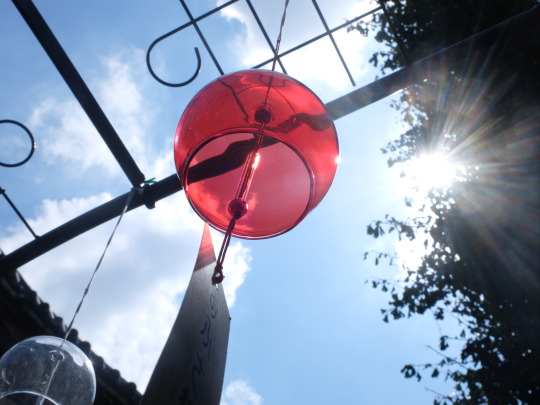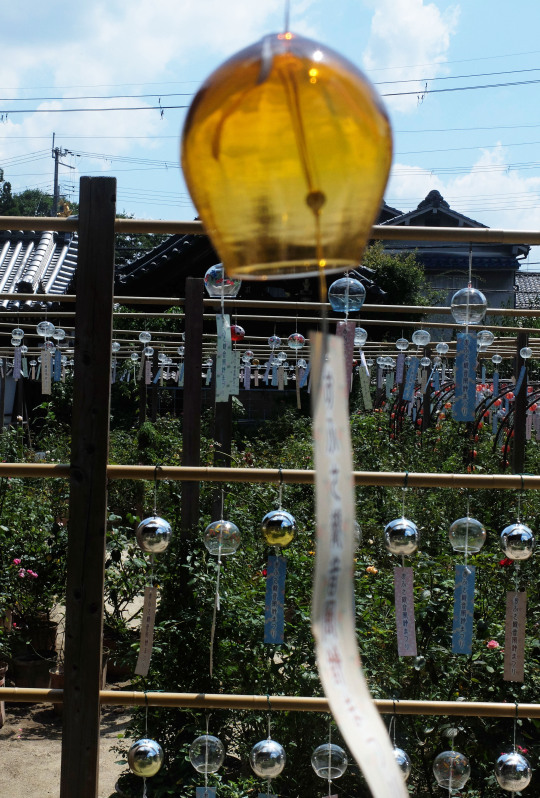#奈良県
Explore tagged Tumblr posts
Photo

#Japan#Nara#Nara Prefecture#Sai Shrine#Sakurai#Shinto#Yamanobe no michi#Yamanobe-no-michi#hiking#travel#Ōmiwa jinja#三輪明神#大神神社#奈良県#山辺の道#桜井市#狭井神社#神道
29 notes
·
View notes
Text
Sangaku Sunday #6

We are about to solve our first sangaku problem, as seen on the tablet shown above from Miminashi-yamaguchi-jinja in Kashihara.
First, we should conclude our discussion: what are sangaku for? There's the religious function, as an offering, and this offering was put on display for all to see, though not all fully understood the problems and their solutions. But a few people would understand, and these would have been the mathematicians of the time. When they visited a new town, they would typically stop at a temple or shrine for some prayers, and they would see the sangaku, a sample of what the local mathematicians were capable of. Whether the problems were solved or open, the visitor could take up the challenges and find the authors to discuss.
And this is where everything lined up: the local school of mathematics would have someone new to talk to, possibly to impress or be impressed by, and maybe even recruit. With the Japanese-style mathematics of the time, called wasan, being considered something of an art form, there would be masters and apprentices, and the sangaku was therefore a means to perpetuate the art.
Now, what about that configuration of circles, second from right on the tablet?

Recall that we had a formula for the radii of three circles which are pairwise tangent and all tangent to the same line. Calling the radii p, q, r, s and t for the circles of centres A, B, C, D and E respectively, we have

for the circles with centres A, B and C (our previous problem), and adapting this formula to two other systems of three circles, we get

for the circles with centres A, C and D, and

for the circles with centres B, C and E. Add these together, and use the first relation on the right-hand side, we get a rather elegant relation between all five radii:

Of course, we can get formulas for s and t,

r having been calculated previously using just p and q, which were our starting radii.
For example, setting p=4 and q=3, we get, approximately, r=0.86, s=0.4 and t=0.37 (this is the configuration shown in the figure, not necessarily the one on the tablet - I will be able to make remarks about that on another example).
#Japan#Nara-ken#Kashihara#Miminashiyama#2018-04#sangaku#geometry#solution#history#Edo period#奈良県#橿原#耳成山口神社#算額#数学#和算
39 notes
·
View notes
Text
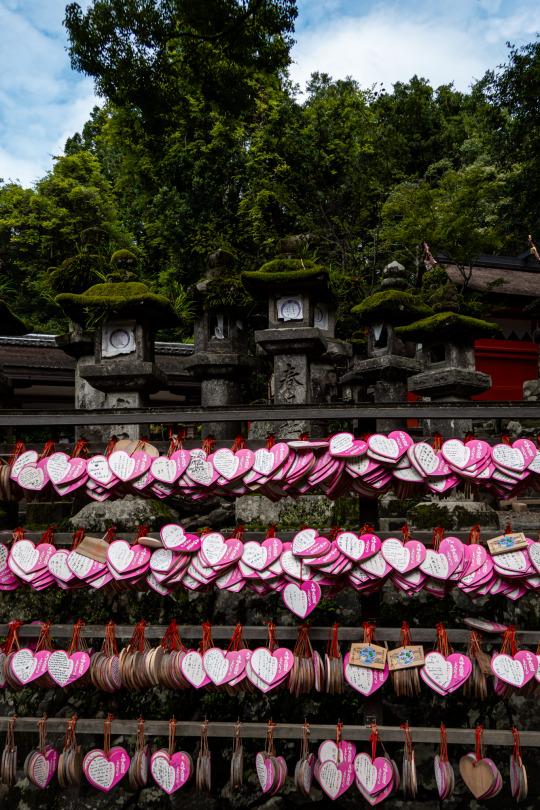
NARA, JAPAN
#Nara#奈良県#Japan#日本#japan vacation#japan travel#japan photos#japan trip#japanese#temple#architecture#colorful#love#travel#trip#heart shaped#photography#photographers on tumblr
96 notes
·
View notes
Text



Sean bienvenidos japonistasarqueologicos a una nueva entrega arqueológica recién salida del horno, se ha descubierto en la prefectura de Nara espejo de bronce en forma de escudo hallado en el túmulo funerario de Tomio Maruyama, dicho esto pónganse cómodos desde que comenzamos. - Características : Mide 64 cm de largo y 31 cm de ancho. Data de finales del siglo IV y tiene 109 m de diámetro. En un examen que se realizó mediante rayos X fluorescentes al espejo con forma de escudo y estaba compuesto de cobre detectó la presencia de estaño, cobre y plomo. La superficie del espejo tenía rastros de que había sido pulido de forma suave. Los patrones geométricos, como es el patrón 'dragón', es una representación simplificada de una bestia divina china posiblemente tuvieran influencia china y los patrones de, los dientes de sierra, que se asemejan a hojas de sierra, se le aplican en la parte posterior. - En el mismo yacimiento se han encontrado: -85 espadas serpentinas en Japón y 4 en Corea del Sur. -La espada serpentina tiene una longitud total de 237, es tres veces más grande que el túmulo funerario de Uda Kitahara que es de 84,6 centímetros localizados en la ciudad de Uda, prefectura de Nara.
Kosaku Okabayashi, subdirector del Instituto Arqueológico de Kashihara, dijo en una conferencia de prensa: "El espejo de cobre en forma de escudo muestra el pensamiento flexible y la creatividad de la gente de la época, así como el alto poder de diseño. Prueba que el nivel técnico de producción fue más alto de lo que había imaginado". - El Túmulo funerario de Tomio Maruyama fue construido en la segunda mitad del siglo IV, dicho túmulo funerario tiene forma circular y es el más grande de Japón. La medición tridimensional con un láser reveló una estructura de tres etapas con un diámetro de 109 metros. La parte principal de la parte superior del montículo fue robada durante el período Meiji, y la piedra kuwagata, que se cree que fue desenterrada en ese momento, ha sido designada como una importante propiedad cultural nacional. - Espero que os guste y pasen una buena semana y nos vemos en próximas publicaciones de Japón.
-
日本の考古学者の皆さん、焼きたての新しい考古学的情報へようこそ。丸山富雄の古墳で見つかった���の形をした青銅鏡が奈良県で発見されました。 - 特徴: サイズは長さ64cm、幅31cmです。 4 世紀末に造られた直径 109 m です。 銅製の盾型ミラーを蛍光X線で検査したところ、錫、銅、鉛の存在が検出されました。 鏡の表面には軽く磨いた跡があった。 「龍」文様などの幾何学模様は中国の影響を受けたと思われる中国の神獣を簡略化して表現したもので、背中にはノコギリの刃のような鋸歯文様が施されています。 - 同じサイトで次のものが見つかりました。 -蛇紋刀は日本に85本、韓国に4本。 蛇剣の全長は237で、奈良県宇陀市にある宇陀北原古墳の84.6センチメートルの3倍以上の大きさです。 橿原考古学研究所の岡林耕作副所長は記者会見で「盾形の銅鏡は、当時の人々の柔軟な思考と創造性、高いデザイン力を示している」と述べた。制作の技術レベルは想像以上でした。」 - 富雄丸山古墳は4世紀後半に築造された日本最大の円墳です。レーザーによる三次元計測により、直径109メートルの3段構造が判明した。明治時代に墳丘上部の主要部が盗まれ、その際に出土したとされる鍬形石は国の重要文化財に指定されている。 - 気に入っていただけて、良い一週間をお過ごしいただければ幸いです。今後の日本からの投稿でお会いしましょう。
-
Welcome, japanesearchaeologists, to a new archaeological delivery fresh from the oven, a bronze mirror in the shape of a shield found in the burial mound of Tomio Maruyama has been discovered in the Nara prefecture. That said, make yourself comfortable as we begin.
-
Characteristics : It measures 64 cm long and 31 cm wide. It dates from the end of the 4th century and is 109 m in diameter. In an examination that was carried out using fluorescent X-rays on the shield-shaped mirror and was composed of copper, the presence of tin, copper and lead was detected. The surface of the mirror had traces of being lightly polished. The geometric patterns, such as the 'dragon' pattern, is a simplified representation of a Chinese divine beast possibly having Chinese influence and the sawtooth patterns, which resemble saw blades, are applied to the back. . - In the same site they have been found:
-
85 serpentine swords in Japan and 4 in South Korea. -The serpentine sword has a total length of 237, it is three times larger than the burial mound of Uda Kitahara which is 84.6 centimeters located in the city of Uda, Nara prefecture. Kosaku Okabayashi, deputy director of the Kashihara Archaeological Institute, said at a press conference: "The shield-shaped copper mirror shows the flexible thinking and creativity of the people of the time, as well as the high design power. It proves that "The technical level of production was higher than I had imagined."
-
The Tomio Maruyama Burial Mound was built in the second half of the 4th century. This burial mound is circular in shape and is the largest in Japan. Three-dimensional measurement with a laser revealed a three-stage structure with a diameter of 109 meters. The main part of the upper part of the mound was stolen during the Meiji period, and the kuwagata stone, believed to have been unearthed at that time, has been designated as an important national cultural property.
-
I hope you like it and have a good week and see you in future posts from Japan.
#日本#歴史#古墳#考古学#日本研究考古学#考古学的発掘#遺跡#奈良#奈良県#日本地理#ユネスコ#丸山古墳#古墳時#japan#history#kofun#archaeology#japanesearchaeology#archaeologicalexcavation#archaeologicalsite#Nara#naraprefecture#Japanesegeography#unesco#Maruyamaburialmound#Kofunperiod#Japaneseprehistory#tsukuridashi#Kashihara
52 notes
·
View notes
Text
入之波温泉山鳩の湯
奈良県吉野の奥にある秘湯


受付。入浴料はちょっと高め😅釜めしは時間がかかるのでお風呂の前に頼む

お風呂は急な階段を降りていく


脱衣所は貴重品入れと鍵付きロッカーもあって安心


毎分500L自噴している自家源泉から加水無しで100%掛け流し

お風呂上がりは���憩所でゆっくり

一息ついたら食堂に


座敷もあります

メニューどれも美味しそう😋



カモ蕎麦と山菜の盛り合わせを注文

山菜が絶品😋ビールが飲みたい🍺

経路にあるダムの景観が絶景。山々の青葉が眩しい


#photographers on tumblr#photo#photography#spa#travel#温泉#写真#ツーリング#バイクで行く景色#nature#吉野#奈良県#history#nara#秘湯#入之波温泉#山鳩の湯#露天風呂#釜めし#鴨#あまご#グルメ#絶景#美味#日本の文化#山菜#蕎麦#シシ鍋#ボタン鍋
9 notes
·
View notes
Text

Mount Unebi as seen from Asuka Village, 1969
Picture postcard from the set "Manyō Ehagaki: Asuka I" (萬葉絵葉書 飛鳥 第一集)
Image from the photography collection of the Nara Prefectural Library
30 notes
·
View notes
Text
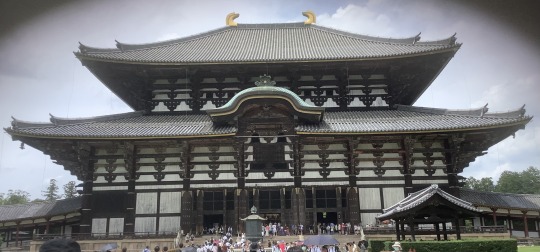
デケェ…
5 notes
·
View notes
Text

奈良橿原の餃子の王将でランチ。
餃子の提供はえてして遅れるもの。
20241001
#food#japan#foodporn#foods#foodgasm#food photography#foodstagram#noodle#ramen#ラーメン#炒飯#奈良#奈良県#餃子の王将#餃子
7 notes
·
View notes
Text




大和郡山市の豆パン屋アポロさんは「Since 2003」。帽子にメガネ、ご自慢のパンを持った看板坊やがいました。イートインを利用したかったのですが、席が埋まってたので、一番人気らしいアンパンとラスクを買って帰りました。
6 notes
·
View notes
Text




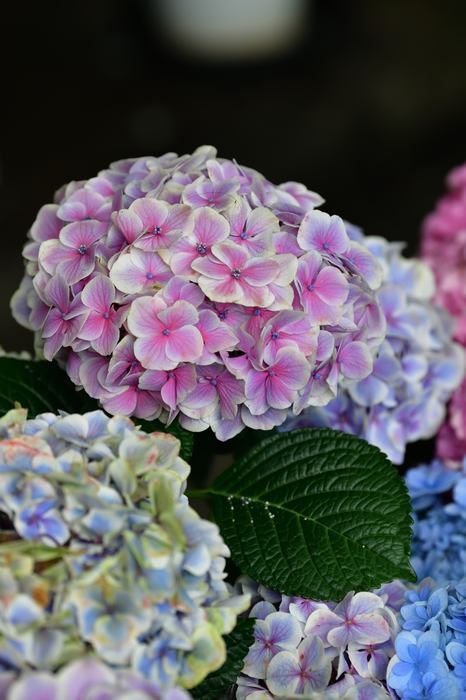
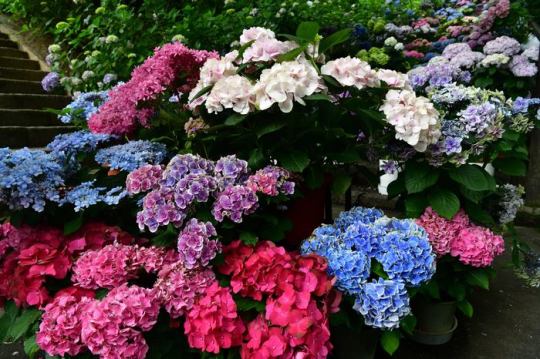


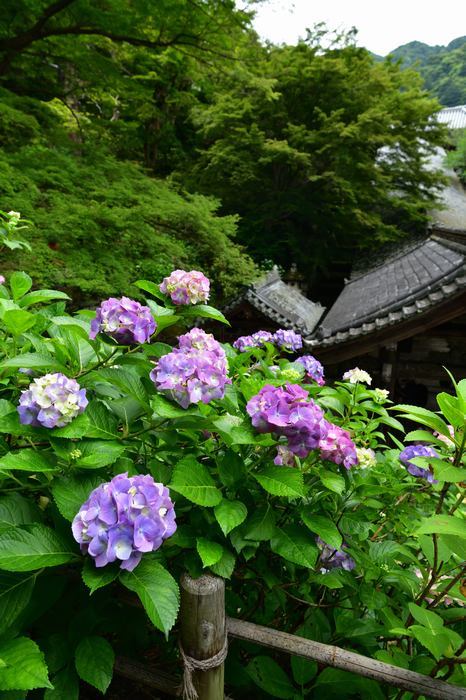

奈良県 桜井市 長谷寺 Nara Sakurai Hasedera
61 notes
·
View notes
Photo

#Buddhism#Japan#Nara#Nara Prefecture#Nenbutsudera#Nenbutsudera 念佛寺#Yamanobe no michi#Yamanobe-no-michi#hiking#hiking photography#travel#仏教#奈良県#山辺の道#念仏寺
25 notes
·
View notes
Text
On the JR Nara line

Uji city and the the building on the 10-yen coin can be accessed by train from Kyôto by going roughly a third of the way to Nara. Other famous sites near the line are Fushimi Inari Taisha (Inari stop), and the studios of Kyoto Animation, famous for the music and sports anime K-On and Free! (Kohata stop).

The most recent type on the route is the 221 Series, and it's already getting on a bit, introduced in 1989. It won one of the Japan Railfan Club's two main new train design awards, the Laurel Prize, the following year. The 221 is used on the fastest Miyakokji Rapid services, which do the Kyôto to Nara run in under 45 minutes.

Green 103 Series sets can also be seen. This is the oldest type still in active JR service (if not, it's close), as it was introduced in 1963. In 2016, when I first visited Japan, I was living near Paris, and some Métro and suburban lines were running trains of a similar age, if not older, and these were atrocious in hot weather - no air conditioning, and ventilation only provided by opening windows! The RATP MP 59 used on Métro line 11 was stinky to boot; it was withdrawn just before the Games, no wonder! Point is, the 103 doesn't have air con either, but is at least trying...

#Japan#Kyoto#Nara#JR West#Nara Line#103 series#221 series#commuter train#calling at#Fushimi Inari Taisha#Kyoto Animation#Uji#京都府#奈良県#JR西日本#103系#221系#train#2016-10#2023-07
8 notes
·
View notes
Text
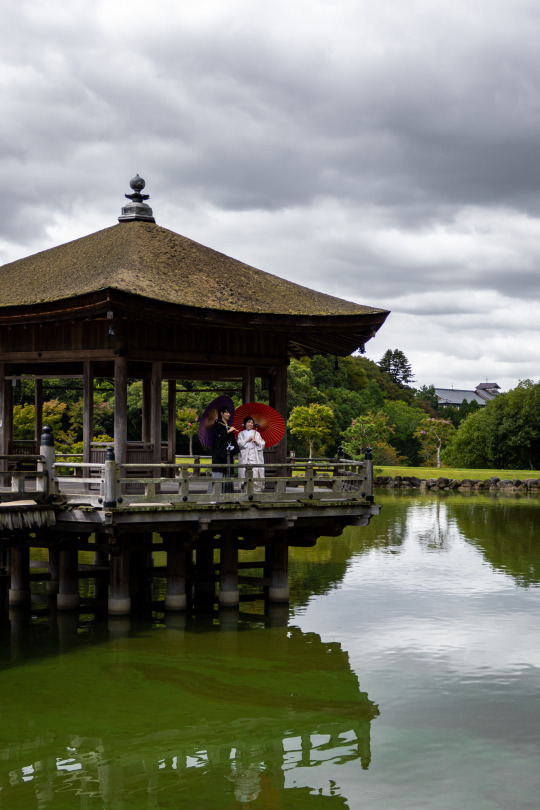
NARA, JAPAN
#Nara#奈良県#Japan#日本#japan vacation#japan travel#japan photos#japan trip#japanese#architecture#historical#colorful#travel#trip#artists on tumblr#urban photography#photographers on tumblr#photography
32 notes
·
View notes
Text





En esta publicación hablaremos sobre el Túmulo funerario de Hirata Umeyama, localizado en el pueblo de Asuka, distrito de Takaichi, prefectura de Nara, mide 140 m y se cree que fue construido a finales del período Kofun VI d.c, fue la tumba de un gran rey durante el período final de la soberanía de Yamato. - Está administrado por la Agencia de la Casa Imperial, que estableció un lugar de culto en el mausoleo Hinokuma-zakaago del emperador Kinmei, cabe destacar que el 90% de los kofun son sagrados. El túmulo funerario de Maruyama localizado en la ciudad de Kashihara, es el túmulo funerario más grande de la prefectura de Nara y el 6º en Japón y tiene una longitud de 318 m, se trata de la tumba del emperador Kinmei. - Cabe destacar que hasta que no se realicen estudios es difícil saberlo, pero como he dicho antes, al ser sitios sacros los estudios son dificultosos. "Konjaku Monogatari Shu" (Colección de cuentos de tiempos pasados), que se completó al final del período Heian, contiene una anotación que sugiere que el túmulo Hirata Umeyama fue la tumba del emperador Kinmei, por lo que ya se pensaba ser la tumba del emperador Kinmei en la Edad Media” - Durante el período Edo, el montículo y sus alrededores se vieron modificados en gran medida, en lo que respecta a su posición original, el túmulo de Hirata Umeyama tiene unas características del período Asuka. Debido a su relación con el túmulo funerario de Maruyama localizado en la ciudad de Kashihara, está a tan solo a unos 700 m de distancia. - Espero que os haya gustado y nos vemos en próximas publicaciones. - In this publication we will talk about the Hirata Umeyama Burial Mound, located in the town of Asuka, Takaichi district, Nara prefecture, it measures 140 m and is believed to have been built at the end of the Kofun VI period AD, it was the tomb of a great king during the final period of Yamato's sovereignty. - It is administered by the Imperial Household Agency, which established a place of worship in the Hinokuma-zakaago mausoleum of Emperor Kinmei, it should be noted that 90% of the kofun are sacred. The Maruyama Burial Mound, located in the city of Kashihara, is the largest burial mound in Nara Prefecture and the 6th in Japan and has a length of 318 m. It is the tomb of Emperor Kinmei. - It should be noted that until studies are carried out it is difficult to know, but as I said before, since they are sacred sites, studies are difficult. "Konjaku Monogatari Shu" (Collection of Tales of Bygone Times), which was completed at the end of the Heian period, contains an annotation suggesting that the Hirata Umeyama mound was the tomb of Emperor Kinmei, so it was already thought to be the tomb of the Emperor Kinmei in the Middle Ages - During the Edo period, the mound and its surroundings were greatly modified. Regarding its original position, the Hirata Umeyama mound has characteristics of the Asuka period. Due to its relationship with the Maruyama burial mound located in the city of Kashihara, it is only about 700 m away. - I hope you liked it and see you in future posts. - 今回は、奈良県高市郡明日香町にある平田梅山古墳について紹介します。古墳第六期末期に築造されたと考えられている全長140メートルの古墳です。ヤマト王権末期の大王の墓。 - 欽明天皇の檜隈坂合御陵に拝所を設置した宮内庁が管理しており、古墳の9割が神聖であることに注目すべきである。 橿原市にある丸山古墳は、全長318mで奈良県最大、全国6番目の古墳です。 - なお、研究してみないとわかりませんが、先ほども言いましたが、聖地であるため研究は困難です。 平安時代末期に成立した『今昔物語集』には、平田梅山古墳を欽明天皇陵とする注記があり、すでに欽明天皇陵であると考えられていた。中世の欽明天皇の - 平田梅山古墳は、江戸時代に墳丘とその周囲が大きく改変されましたが、その原位置は飛鳥時代の特徴を持っています。橿原市にある丸山古墳との関係で700mほどしか離れていない。 - 気に入っていただければ幸いです。今後の投稿でお会いしましょう
#平田古墳#日本#歴史#人類#ウネスコ#明日香村#奈良県#古墳時代後期#律令制#飛鳥時代#丸山古墳#橿原市#蘇我の墓#都塚古墳#平安時代#飛鳥歴史公園#欽明天皇#HirataKofun#Japan#History#Humanity#AsukaVillage#NaraPrefecture#LateKofuPeriod#AsukaPerid#MaruyamaKofun#KashiharaCity#Sogatomb#photography#geography
29 notes
·
View notes











